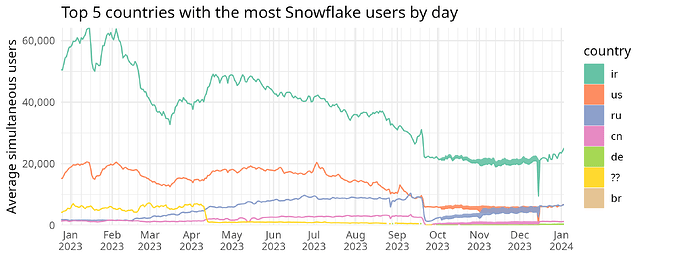This is a summary of usage of the Snowflake pluggable transport in 2023. For the previous year’s summary, see the Snowflake 2022 year in review.
The primary Snowflake bridge, called snowflake-01, is supported by donations. In 2023, the Snowflake Daily Operations team paid about €4,820 in hosting expenses to keep the bridge running—with most of that going for bandwidth. In 2024, in addition to paying for bandwidth, we would like to buy new hardware for the bridge, which will enable it to support more users at the busiest times of day. You can help by donating to support the bridge.
Donate funds for the snowflake-01 bridge
Let’s start by looking at the daily users and bandwidth. Tor user graphs show an estimate of the average number of simultaneously connected users (not unique IP addresses). For instance, if the line passes through 40,000 on a particular day, it means there were, on average, 40,000 users connected to Snowflake at any given time during that day. The bandwidth graph shows the total amount of Tor traffic transferred per day. As of January 1, 2024, Snowflake supported an average of about 40,000 simultaneous users and transferred about 35 TB of circumvention traffic per day. While the number of users is lower than it was at the beginning of the year, bandwidth is up by more than 50%.
These are some of the events that affected Snowflake usage in 2023:
- Between 2023-01-16 and 2023-01-24, and intermittently thereafter, domain fronting rendezvous was blocked in parts of Iran. As more Snowflake users are in Iran than in any other country, this resulted in an observable decrease in the number of users.
- On 2023-03-13, the Tor anti-censorship team fixed a security bug that had also negatively affected performance since September 2022. This greatly improved bandwidth for all users.
- The big drop in users on 2023-09-20 was not caused by a censor. Rather, it was an unexpected change in the infrastructure used by Snowflake for rendezvous. Mitigating the problem required new software releases.
Before 2023, we had used just one, centralized Snowflake bridge. Last year we started using a second bridge in order to scale to more users. Here are the same user and bandwidth graphs, but with the snowflake-01 and snowflake-02 bridges shown separately. Strangely, the domain front change of 2023-09-20 affected the two bridges differently.
We can also break down users by country. The largest contingent of Snowflake users are in Iran, which has been the case since the Mahsa Amini protests in 2022. The graph shows also a large number of users apparently from the United States, but we believe that may be partly the result of geolocation errors, and many of them are actually from Iran. After Iran, the countries with the most Snowflake users are Russia and China. On 2023-04-10 the team fixed a bug in the browser proxy that caused some users to be wrongly attributed to the unknown “??” country code. The cause of the per-country user count estimates becoming less precise between October and December was a user-counting bug in Tor that existed from version 0.4.8.4 until 0.4.8.10.
To reproduce these figures, run snowflake-2023.r in the snowflake-graphs repository at commit ff832355.




